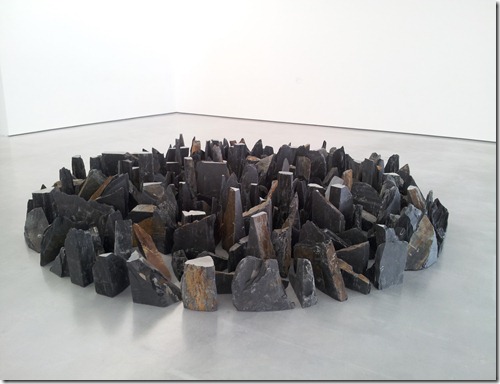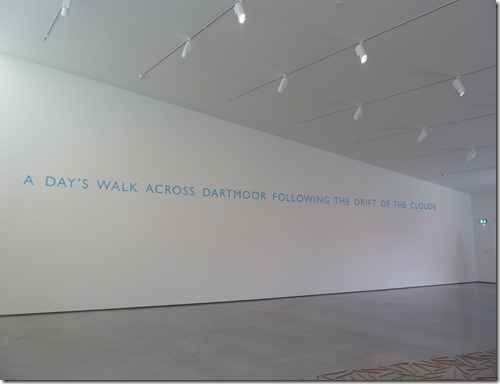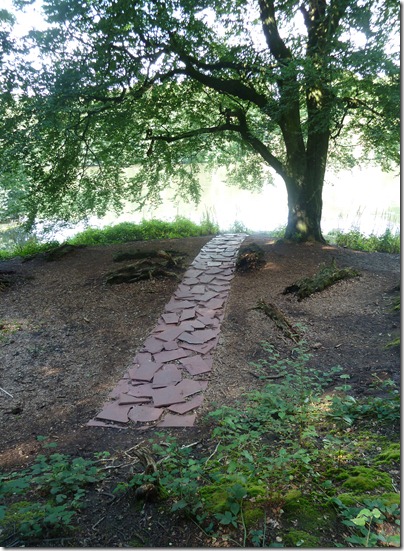Uncommon Ground is a touring exhibition of works drawn from the Arts Council Collection. It’s showing at the Longside Gallery at the Yorkshire Sculpture until the middle of June, so we took the opportunity to visit while we were over at the YSP the other Saturday.

The YSP’s website tells us
In the late 1960s artists on both sides of the Atlantic turned away from the enclosed space of the gallery and went out into the landscape to forge a new form of art. This art was made in radically new ways often using earth, water, sun and even fire as raw materials, and went under several names: land art, earth art, process art, and conceptual art. Drawing largely from the Arts Council Collection and supplemented by important loans from artists and major public institutions,Uncommon Ground: Land Art in Britain 1966 – 1979 takes a fresh look at the art of this period and considers what was particular about the way land art developed in Britain.
The exhibition featured works that reflected the main aspects of the movement – moulding the landscape itself, using materials taken from the environment, creating a temporary impression and even walking.
We’ve seen numerous works by Richard Long, Anthony Gormley, David Nash and Andy Goldsworthy over the past few years and have become “fans” so it was interesting to see the early examples featured in this exhibition. And, as is often the case, there were works by artists who I’d never heard of previously and so I was able to make some new discoveries.
The works were very well displayed in the Gallery. The long view of the parkland through the windows which extend all along one side of the building really complemented them and provided an appropriate context – almost like an exhibit itself.
No photographs were allowed in the gallery, so the following pictures of some of my favourite works on display have been sourced via th’Internet.
This is Fallen Tree (1979) an early work by Anthony Gormley, best known for his figurative sculptures based on his own body.

The work was created by taking slices from a tree trunk and then arranging them in a spiral starting at the centre with the smallest piece and then working outwards, increasing in size.
It reminded me very much of the work of Richard Long, one of whose works, Stone Circle (1972) consisted of stones laid out in a circle

Richard Long made his mark (literally) with A Line Made by Walking (1967) he walked back and forth along a straight line in the grass, leaving a track that he then photographed in black and white.

The idea of creating art by walking, where the act of walking itself can become a work of art but where the artist leaves a mark on the landscape in some way, some more ephemeral than others, was, and remains, a trend in Land Art. A number of examples, including A Line Made by Walking, which we had seen before, were featured in the exhibition. The act is usually recorded in some way, usually by photographs, but sometimes by leaving a mark on the landscape – sometimes temporary (although often photographed to record for posterity) or more permanent, like the piles left by Richard Long on another of his journeys that was featured in the exhibition.
Another aspect of Land Art is the use of materials taken from the environment. This is typified by David Nash, the master of using wood harvested from “wood quarries”. There were examples of his work on display, including Silver Birch Tripod, 1975.

and Ash Dome a ring of 22 growing ash trees into near Nash’s home in North Wales, bent to form a living dome.
An early work by Tony Cragg, New Stones – Newton’s Tones (1978), took materials from the environment too, but in this case they’re pieces of plastic waste recovered from the Rhine and displayed in the order of the colours of the rainbow.

Andy Goldworthy also uses materials from the landscrpe, in many cases for on-site installations that use only the materials available on site such as rocks, leaves, branches, snow and ice. These works are often ephemeral, eroding, decaying, crumbling or melting and the only evidence for their existence are the photographs that he takes. There were several examples in the exhibition including Snowball 1979

There were several more permanent works by Roger Ackling, who used sunlight to burn patterns into wood or paper, creating primitive photographic prints. One example was ‘Night and Day’ (1 hour), 1977.

There were films too. Sometimes constituting the work itself, like Dereck Jarman’s A Journey to Avebury 1979, or a record of an event, like the Anthony McCall’s Landscape for Fire II, 1972.

Photographs featured quite heavily in the exhibition – sometimes to record ephemeral works, as a record of an event or to show dramatic landscapes (I found the selection of photographs Sea Horizons by Garry Fabian Miller of the Bristol Channel under different conditions particularly affecting – pity about the reflective glass that made it difficult to view them properly). But they were used in other ways too. An example of the latter was John Hilliard’s Across the Park 1972. This is a series of pictures where a single shot is cropped in different ways providing very different interpretations of the same scene. Very clever, I thought and demonstrating how images can be manipulated and how “truth” depends on editing and perspective.
The exhibition provided a good opportunity to explore the origins of Land Art. It was particularly interesting to be able to see early works by artists we like, to see their early ideas and the beginnings of trends that they developed further during their career or, in some cases, abandoned to take other directions.











































